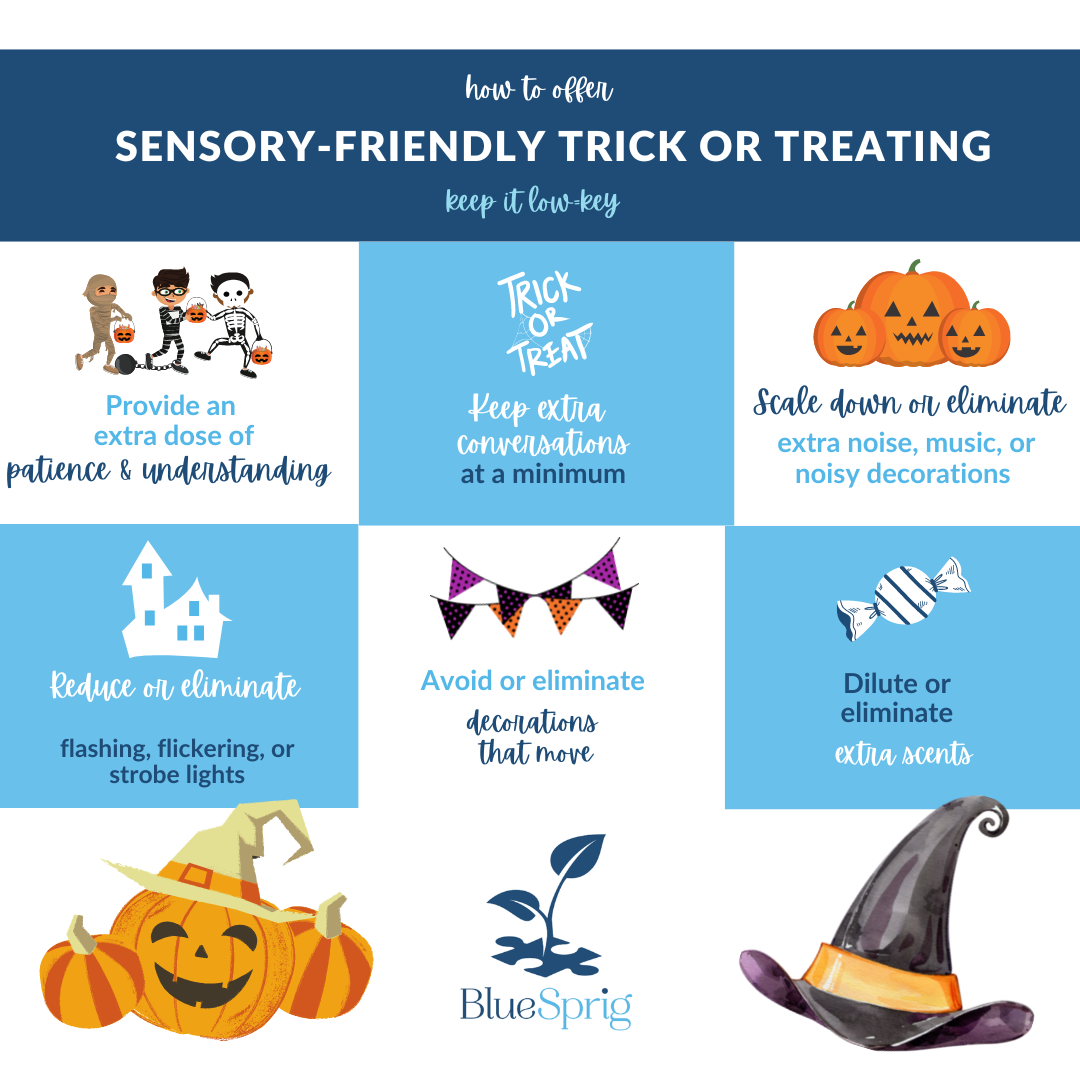For most kids, October is all about Halloween – from the costumes and decorations to scary movies and candy, the holiday is considered a favorite by many. But for children with autism and other sensory differences, Halloween can be both cherished and challenging. It’s cherished for all of the reasons kids love Halloween (Costumes! Candy! Fun!), and challenging due to the extra sights, sounds and crowds that the holidays bring. To help this Halloween be more “treat” than “trick,” we’ve compiled our best tips to help you prepare for the spooky day.

Hosting a Sensory-Friendly Trick-or-Treat Hour
We suggest a sensory-friendly alternative to traditional trick-or-treating by hosting a Sensory-Friendly Trick-or-Treat Hour. Here’s how it works:
- Create your community: A few houses (or a whole block!) agree to offer a coordinated hour (or two!) of trick-or-treating for children minus the light-up decorations and overwhelming sounds.
- Share the news: The community can promote the hour to families who may be looking for sensory-friendly solutions by posting on neighborhood boards like NextDoor, closed Facebook groups and others, noting which houses/areas will offer the Sensory-Friendly Trick-or-Treat Hour.
- Reduce or eliminate lights, noise, or decorations: Consider taking your child or loved one trick or treating during the day to avoid Halloween lights. This will help prevent overstimulation from the flashing or flickering lights. While planning the sensory friendly trick or treating with your community, ask that they turn off any distracting noises or decorations that move during this planned time.
- Provide an extra dose of patience and understanding: By preplanning this with your community, it will help those involved with a better understanding of how to provide a sensory friendly trick or treat. Remember to keep conversations at a minimum to avoid distractions and keep your loved one engaged!
Another great sensory-friendly option is Trunk or Treating. Organizing a trunk or treat may be a great way to include folks from different streets/neighborhoods and is often a very safe way for kids to participate in the trick-or-treat tradition. Attending or hosting a trunk or treat on a day or night other than Halloween may be a great idea to miss some of the over-stimulating elements that Halloween can bring.
Halloween Tips and Tricks
- Dress Sensory-Friendly: Let your child choose a costume they feel comfortable in. Consider Halloween-themed PJs, a Halloween shirt, or costumes that fit over normal clothes, like capes or butterfly wings. These are great options for getting into the holiday spirit without causing discomfort.
- Practice Trick-or-Treating: At home, stage a practice round to help your child become familiar with the process. Make sure to go over getting dressed up, trick-or-treating, Halloween parties, and any other Halloween activities you plan on participating in.
- Plan Appropriately: Bring along items that your child finds calming, such as a favorite toy, headphones, fidget toys, etc. It’s possible that your child may feel overwhelmed and need to leave early. Having an exit plan in place can help reduce stress.
- Know Their Limits: If you’re trick or treating with your child, let them go at their own pace. Some children take to Halloween and want to keep trick or treating all night long. Others may want to stop after just three houses. Starting small and building up to more houses each year ensures Halloween stays as stress-free as possible.
- Consider Alternate Activities: If your child doesn’t care to trick or treat, consider going to a community event, school festival, or neighborhood party instead. These events may be less overwhelming than approaching strangers’ houses.
- Have a Plan for the Candy: If your child has dietary restrictions, you’ll need a plan for what to do with your child’s Halloween candy. Consider having your child trade in their candy for an outing they enjoy or a toy they’ve had their eye on. Make sure they’re ready by sharing the plan with them as often as necessary.
Create The Best Halloween Memories
Have perspective. Remember that every child is unique, so it’s important to tailor these tips to your child’s needs and preferences. The goal is to create an enjoyable and comfortable Halloween experience for everyone involved!
As Halloween approaches, preparation can help parents and children deal with changes in routine, sensory sensitivities, and unusual social interactions. We hope you and your family have a happy Halloween! Tag us on social at @bluesprigautism to show how you and your family are celebrating Halloween this year!